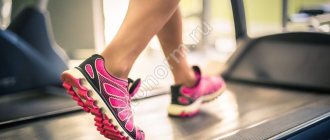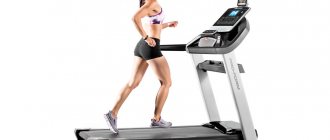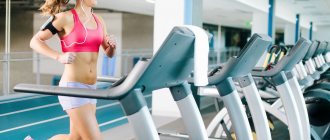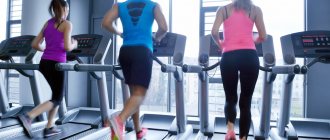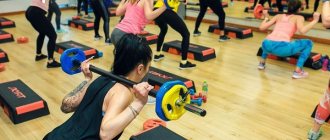How effective is a treadmill in losing weight?
Before starting training, most people are interested in how long to run on a treadmill in order to lose weight and achieve the maximum effect from exercise.
Trainers emphasize that each person burns calories at an individual pace. This indicator is influenced by body weight, level of physical fitness, duration and regularity of training, and nutritional pattern.
Most exercise machines have a calorie counter, but you shouldn’t trust it completely. The device produces an average indicator, especially for the first 10 minutes of training. At this time, the human body does not have time to use fat reserves, but only uses glycogen and glucose.
A treadmill is effective for weight loss if exercise is regular and lasts at least 30-40 minutes.
Three convenient interval programs for the treadmill
Don't have time to walk every day for 1-2 hours? Choose a different lesson format. Interval training is effective for weight loss if done for just 30-50 minutes every 2-3 days. This option is optimal for those who have average or excellent physical fitness. Interval training involves frequent changes of strong and moderate loads. Beginners should create a program so that intense exercises take up no more than a third of the total time. For trained people, the optimal ratio of moderate to strong loads is 1:1.
Beginners can combine regular walking with incline walking or light jogging. Well-trained people combine moderate to high speed running and incline running.
A complex for those who love to walk
This interval training for beginners takes place in three stages:
- 1. Walk at normal speed for 5 minutes.
- 2. Walk at normal speed at a slight incline for 2–5 minutes. It is better to start with a minimal inclination.
- 3. Brisk walking 3 min.
The complex is repeated 4–8 times. If you find the activity difficult, reduce the time and number of repetitions.
A simple routine of running and walking
This treadmill weight loss program consists of two stages:
- Walking at a speed of 5–6 km/h for 5–10 minutes.
- Running at a speed of 10–13 km/h for 3–5 minutes.
The sequence is repeated 4–8 times. Once your body gets used to it, you can increase your running speed or add an incline.
Intensive complex for those who exercise for a long time
The program is suitable for trained people. You need to start by warming up or walking for 5 minutes. The training includes the following stages:
- 1. Walking at a speed of 6–7 km/h for 3–5 minutes.
- 2. Running at a speed of 11–12 km/h for 3 minutes.
- 3. Repeat the first stage.
- 4. Running at a speed of 12–14 km/h.
Then alternate running and walking according to the same principle. At the same time, the running speed needs to be increased a little each time. When you start to get tired, reduce your speed by 1-2 km/h on each new lap. It is better to finish your workout with stretching. Over time, you can add walking or running on an incline.
How to run on a treadmill to lose weight
Trainers advise following several rules to get the maximum effect from running.
- Don't neglect warming up. This will help the body tune in to active work. Another reason to start a session with a warm-up is to warm up the muscles to prevent injury.
- The load in time and intensity should be increased gradually. This is especially true in cases where a person does not have physical training.
- Regular training is the most important requirement for achieving good results.
- You can speed up weight loss by changing running modes: alternating running with intense uphill walking and fast running.
What is the first thing you lose weight when running?
There are rumors that with the help of running and other workouts you can lose weight specifically in your legs or riding breeches, but this is not true. The reduction in body fat occurs evenly and regardless of which muscles are worked when running on a treadmill. This is explained by the characteristics of the human body. But it can be emphasized that men and women lose weight differently.
- The female figure most often belongs to the gynoid type. In this case, fat accumulates first in the lower part of the body - thighs, buttocks and stomach, and the upper body is often used last. As for losing weight, the process occurs in the reverse order. First, the extra centimeters begin to disappear from the upper part of the body, and then from the lower part. Therefore, when losing weight, many girls complain that they lose volume on their chest and face, instead of the desired centimeters on their legs and butt.
- The male figure in most cases is of the android type - prominent muscles and narrow hips. In this case, excess weight first begins to appear in the abdominal area and only then is distributed throughout the body. That’s why men over 30 often receive a beer belly as a “gift.” In the process of losing weight, the fat layer is primarily reduced on the arms and legs, and only then on the chest, shoulders and abdomen.
Losing weight is a complex process, and you won’t be able to target just a specific part of the body. Be prepared for this and don't stop halfway.
Running and figure
When trying to burn extra pounds by cutting back on food, you need to take into account many points that are often taken into account incorrectly in classic diets. This is why running on a treadmill is better for weight loss than crash diets. These points that are important to pay attention to when trying to lose weight are listed below:
- combination of proteins and carbohydrates,
- presence of omega 3 fats,
- correct calorie calculation,
- consumption of fiber and vitamins,
- distinguish carbohydrates based on the rate of absorption and glycemic load.
And even in this case, the body, most likely, will first begin to burn not fat cells at all, but protein cells. Which will lead to:
- deterioration of the condition of the skin and hair - split ends, skin looks flabby,
- deterioration of the condition of joints and ligaments - they simply dry out, which increases the risk of injury,
- reduction in muscle volume - instead of an elastic butt and chest, you will have saggy legs and arms. And the “orange peel” will not disappear anywhere.
Read also: Trapezius exercises
What happens during physical activity? Particularly when running. At first, until the body is accustomed to constant cardio loads, resources are optimized. Building heart and leg muscles. Due to this, the protein component increases. Therefore, after the first week, the weight may increase by 200-400 grams. After this, glycogen begins to be stored in the muscles (another +0.5-1 kg of weight). At the same time, the main working muscles, calves and buttocks will be visually tightened in the figure. As a result, after a week of running, and even in combination with the gym, the weight, instead of falling, will begin to grow. Because of this, many, afraid of “Oshvartsenegirization,” will abandon this matter (we are talking exclusively about ladies).
After this, when the main systems of the body are ready, fat burning will begin, the calculation of which was carried out earlier. Further, by creating a moderate calorie deficit (no more than 10% of the norm), you can lose 50-80 grams of fat tissue every day. And this is up to 3 kilograms per month.
Naturally, if we take pure weight loss, then we can add those kilograms that will go away with:
- reducing the amount of salts,
- reduction of water in the epidermis,
- reducing slagging (due to increased metabolism).
But most importantly, a woman will be able to maintain her figure, and in many places even tighten it.
By correctly combining a balanced diet, heavy anaerobic exercise and treadmill running, you can speed up your weight loss results by 2-3 times.
The benefits of running
Running is an aerobic exercise that develops endurance by saturating the entire circulatory system with oxygen.
Regular running has a positive effect on the entire human body, activates the proper functioning of many organ systems, promotes weight loss and increases endurance. In the list of the most common reasons for running, athletes name:
- muscle strengthening;
- weight loss;
- heart muscle training;
- stress relief.
For the cardiovascular system
The treadmill belongs to the category of cardio equipment. By running, a person trains the heart muscle, as a result of which endurance increases, blood pressure returns to normal and overall well-being improves. These changes in the body help relieve stress and restore psycho-emotional background.
For the respiratory system
Long running is accompanied by active breathing. This leads to increased work of the lungs, their training and increase in volume. In addition, intense breathing enriches the blood with oxygen, which is distributed to all organs and accelerates cellular nutrition and metabolism.
Running is considered one of the basic mechanisms provided by evolution to preserve and maintain health and life. In addition to the obvious benefits, jogging promotes the production of endorphins, which make a person feel joy, happiness and optimism.
Some tips for running on the treadmill
To understand how to run on a treadmill correctly, you should consider several criteria that affect the effectiveness of exercise. Following simple tips will help you get the maximum effect when losing weight and prevent injury.
Warm-up is required
Starting a workout with running, especially fast running, is a common mistake for beginners. Trainer's tip: First, do a short warm-up. This could be squats, turns, stretching. Such actions warm up the joints and muscles for further more active work.
Lack of preparation increases the risk of injury, sprains, dislocations, and joint diseases. When starting to run, you should walk for several minutes, gradually accelerating the pace.
Monitor your pulse
The speed of the heartbeat and pulse largely affects the burning of calories, therefore, the more intense the workout, the greater the effect you can achieve when losing weight. It is important to take into account that high stress on the body is strictly contraindicated. Otherwise, the person may feel dizzy and their general condition may deteriorate sharply.
The optimal heart rate (HR) during exercise is considered to be 120 beats per minute. With such a load on the body, active fat burning occurs. However, when calculating, it is important to take into account your individual indicators - body weight, age and physical fitness.
This amount can be calculated using the following formula. It contains only 2 indicators:
- the maximum permissible heart rate (220 beats) is a constant value;
- person's age.
For example, for a 30-year-old athlete, the optimal heart rate during training will be 220-30 = 190 beats.
Increasing loads
Those who want to get rid of extra pounds often start with an increased load. In their opinion, this should speed up the process of burning calories, but experienced athletes advise refraining from this training regimen.
A sharp increase in the load on the body leads to malaise, general deterioration of the condition, and exacerbation of chronic diseases. In this case, the question arises of how to run on a treadmill with maximum efficiency, but without harm to the body.
Each week you should increase the load by 5% compared to the previous week of classes. In addition, experienced athletes are not advised to increase both training time and intensity at the same time.
The duration of training at the first stage should not exceed 30 minutes. Classes lasting less than 20 minutes are ineffective.
Intensity
You can increase the effect of your workout by changing the intensity of your running. You should start your exercise with walking, but this exercise is not enough for effective weight loss.
The best option is to alternate the load, as with interval running. After 5 minutes of warm-up walking, about 20 minutes of jogging is recommended, followed by intense jogging. Instead, the maximum load can be provided by walking on a path with a slope.
The maximum load on a treadmill occurs when running at high speed on an incline, but this method is only suitable for people with sufficient experience and training
Hitch
Just like warming up at the beginning of class, cooling down at the end is of great importance for the overall result. For this reason, experienced athletes never neglect this exercise. The cool down has a number of tasks:
- Restoration of respiratory function. If you don't cool down regularly, it can lead to shortness of breath.
- Decreased heart rate. A cool-down is light physical exercise that lowers your heart rate. If this is not done, the cardiovascular system will continue to work at an increased rate, which can lead to the development of many diseases.
- Accelerated recovery of muscle tissue. While running, muscles are trained. In addition, a large amount of lactic acid (a product of oxygen processing) accumulates in the runner's legs. The athlete's muscles become clogged.
- Working at a low heart rate promotes accelerated removal of lactic acid and restoration of muscle tissue.
The runner’s speed, time and heart rate can be tracked on the treadmill display, or on a special watch that reads the indicators
As a cool-down, you can use exercises such as: jogging, bending to the ground, walking on your heels, stretching
Treadmill for weight loss
Cardio exercise is effective for weight loss because it burns a large number of calories. In addition, long-term cardio stimulates the burning of fat reserves after processing energy from carbohydrates.
In terms of energy consumption, running on a treadmill exceeds exercise on a stepper, elliptical and exercise bike, and also almost catches up with a rowing machine - 600 kk/hour versus 700 kk/hour. It is not surprising that the treadmill is often chosen for home weight loss, and this is quite justified if you run correctly and regularly, without exceeding the calorie allowance per day.
Muscle work during training on the treadmill
When exercising on the treadmill, the same muscles work as when running: legs, core, a little back and arms. The load on the muscles increases as the intensity of the workout increases and decreases when exercising at a slow, calm pace. The least load on the muscles is when walking, the greatest is when running at speed and intervals.
Treadmill training uses the following muscles:
- gluteals (large, medium and small), which are responsible for the position of the body in space
- biceps and quadriceps of the thighs, responsible for flexion and extension of the knees during walking and running
- gastrocnemius, responsible for maintaining body balance
- muscles of the lower leg (anterior and posterior tibialis), which are responsible for extension and rotation of the foot, as well as for bending the leg forward
- flexors and extensors of the toes and peroneal muscles, responsible for the movement of the outer part of the foot
Some types of running actively use the muscles of the core and arms:
- iliopsoas, responsible for hip flexion and rotation
- rectus abdominis muscle, which helps maintain correct body position
- intercostal muscles, which are activated during intense breathing
- biceps and triceps, working with the dynamic movement of the arms while running
- back muscles responsible for fixing the body in a straight and inclined position
During exercise on a treadmill, the muscles of the whole body are involved in the work; in addition, the load on certain areas can be adjusted by changing the mode and angle of inclination of the belt.
Is a treadmill effective for losing weight?
Considering the high energy consumption of running, we can say that exercise on the treadmill is effective for losing weight, especially if you exercise regularly and adhere to a proper diet. There are several reasons why the treadmill will help you lose weight:
- Running or walking at a fast pace speeds up your metabolism, gets your blood pumping and forces your body to burn fat reserves.
- Thanks to the walking distance of the simulator, you can exercise every day and even several times a day, if you have the strength and desire.
- You can train at any rhythm, the main thing is to gradually increase the load to avoid rapid adaptation of the body.
- People with significant excess weight can exercise on the treadmill, since most models are designed for a maximum user body weight of 120 kg.
- On a treadmill you can burn up to 600 kcal per hour of training if you run at an average pace.
Even if regular cardio exercises do not reward you with pronounced relief, you can definitely lose 2-5 kg per month. The main thing is not to skip workouts and not to make up for lost calories at dinner.
Treadmill: for running and for walking
The versatility and customization of the treadmill allows it to be used for various fitness purposes. Not all people can run for health reasons, but everyone can and should walk, because it is the most natural and healthy activity for a person.
- Running on a treadmill is recommended for people with training experience, athletes, and beginners who are confident that there are no contraindications.
- Walking on a treadmill is recommended for the elderly, those recovering from an illness or injury, and people who are overweight.
- Untrained beginners should also start with walking and increase the load gradually so as not to injure the joints and ligaments.
Walking on a treadmill is no less effective for losing weight than running. When walking over long distances, 300-400 kk/hour is burned. In the first half hour or hour, not many calories are burned, but if you stick to the same rhythm for another 30-40 minutes, then energy will be released more intensely and the body’s fat reserves will be used. Walking exercises are effective not only for losing weight, but also for improving mood, muscle tone, and preventing many diseases, including age-related changes in the body.
10 Tips for Training on the Treadmill
- Work out in shorts, a top and definitely running shoes. Sneakers, moccasins, sneakers and other shoes are not suitable for running, even if you are training at home.
- Keep a bottle of water within walking distance, as running on a treadmill can cause dehydration much faster than running outside. It's all about the lack of aerodynamics and dry indoor air.
- Before running, do a joint warm-up to prevent dislocations and sprains. A light warm-up gets the blood pumping and improves coordination.
- Start at a slow pace and gradually increase your speed. Starting with sprints and speed runs is not only ineffective, but also dangerous.
- Follow your running technique, and to do this, look not at the track, but straight ahead, keeping your back straight.
- Avoid holding onto handrails, especially while running. If you find it difficult, reduce your speed. It is better to walk than to hold on to the handrails, reducing the effectiveness of your workout.
- Choose a mode according to your training experience. If you are a beginner, you should not experiment with the incline angle and running at extreme speeds to avoid injury.
- Do not run on a full stomach, and immediately after training, do not eat for another half hour or hour until the body restores pulse, breathing and blood pressure.
- Don't drink, answer calls or change music while running! Don't put yourself in danger.
- After exercising, let the track cool and then wipe it with a cloth. This is especially important if you work out in the gym, but also at home, make sure that the machine is clean so that it lasts you as long as possible.
Heart rate while exercising on a treadmill
You should monitor your heart rate while running not only to effectively lose weight, but also to feel good and not harm your body.
When running, a beginner's heart rate should not exceed 75% of the maximum for your age. It can be calculated using a simple formula:
Maximum limit of 220 – age = maximum for you. For example, for a 29-year-old person, the maximum safe heart rate would be 191 beats per minute. But you shouldn't aim for an extreme heart rate, especially if you're new to running. Moreover, fat reserves are perfectly burned at a heart rate of 70% of the maximum for your age. For the same 29-year-old person, the optimal heart rate would be 134 beats per minute (191*0.7=134 or 70%).
Stay within your safe heart rate zone to effectively lose weight while running.
Treadmill Running and Walking Plan for Beginners
To improve your shape and lose a little weight, it is enough to do the following program every day or every other day:
- 5-10 minutes - slow walking, during which do light stretching: transfer your body weight from heel to toe and back, rise on your toes or move on your heels. This way you can easily stretch your leg muscles and warm up your joints. You can hold on to the handrails while warming up. Warm up for 2-5 minutes, and then proceed to a brisk walk of at least 6 km/hour.
- 10-15 minutes – jogging at an average pace of 7-9 ks/hour. After the first 5 minutes, increase the angle of the blade by 2-5 degrees.
- 10 minutes is the maximum possible speed. Increase your speed to your maximum speed and run for 2 minutes. Then reduce the speed to a comfortable speed for 3 minutes and increase again for 1-2 minutes, reduce again and repeat several circles.
- 5 minutes – increase the load. The last stage should end with walking at a comfortable pace, from which you move on to more intense walking with an inclination of 10-12 degrees. After 3 minutes, slow down gradually, reducing the angle of the blade to the minimum
- 5 minutes – walking at a calm pace, during which you can stretch your shoulders, arms, back and legs, as at the beginning of the workout.
For complete beginners, just select the walking mode and exercise for 20 minutes every day. After the first week, progress to running for 10 minutes, followed by walking for 20 minutes. Gradually increase the amount of running and reduce walking to 5-10 minutes per workout.
How to choose running shoes for the treadmill?
For exercise on the track, only running sneakers or all-purpose ones with lightly cushioned soles, durable lacing and a high heel to protect the ankle while running are suitable. An important factor is the type of pronation of the foot, which should also be taken into account when choosing a model.
For example, the following sneakers are suitable for running on a track:
- Men's NIKE FS Lite Run 4 for neutral foot pronation with a two-layer sole with shock absorption.
- The women's ASICS Patriot 1 features enhanced foot and heel support and a flexible outsole.
- Men's REEBOK PT Prime Run 2.0 with cushioning and excellent support for the foot.
- The women's Nike Flex Experience RN 8 is designed for neutral pronation with enhanced traction and arch support.
Given the flat surface of the path, choose shoes with good grip. Do not buy models that are too heavy, as training on the machine takes place indoors and you will become very hot. Lightweight sneakers with a mid-thick sole, cushioning and good foot support are the best choice.
Time to study
Professionals do not give clear recommendations regarding the timing of training. The choice largely depends on your daily routine and your personal preferences.
Many people choose to train in the evening after work. In this case, with the help of running you can not only improve your figure and health, but also get rid of the stress that has accumulated during the day.
If it is more convenient for an athlete to exercise in the morning, the training will be no less productive. Afterwards you should take an invigorating shower. As for breakfast, it should be light and 30-40 minutes after class - oatmeal, yogurt or an apple.
If an athlete trains on a machine at home, he can choose the training time at his own discretion.
Calculation of calories burned during exercise
- With intense walking, women manage to get rid of 250 kcal in an hour, and men - from 330 kcal.
- Running in place or jogging in an hour eliminates 560 kcal in women and 840 kcal in men.
- Fast running helps burn 560 kcal in women and 840 kcal in men.
- When climbing uphill 700 is burned in women and 920 kcal in men.
The greater the speed, intensity and load, the more calories are burned.
Safety precautions
The treadmill in gyms holds the record for the number of injuries. To reduce the risk of slips and falls, follow these simple safety rules:
- Some models of exercise machines are equipped with handrails. It is highly not recommended to hold on to them when running at speed. This is explained by the fact that the runner's body assumes a stooped position, which is incorrect for running. As a result, the load on the musculoskeletal system increases, and at the same time the load on the spine and joints increases.
- When moving quickly, do not look at your feet or at the moving road surface. In this case, you may lose your balance and fall. When running, it is better to keep your arms at an angle of 90 degrees and your body slightly tilted forward.
- Don't jump off the track at high speed. This can lead to foot and ankle injuries. First, it is better to slow down the movement of the treadmill belt, completely stop the machine and then get off it.
- The choice of shoes should be approached extremely carefully. During intense running, the foot needs reliable support and shock absorption. In other words, sneakers should be specifically for running: lightweight, fit properly, and have a soft sole with good cushioning.
Choose running shoes to protect your feet from stress and injury
The effectiveness of these workouts for weight loss
With regular exercise, brisk walking or running is a fairly effective way not only to lose excess weight, but also to avoid gaining it in the future. By changing the incline of the treadmill and increasing the speed, you can tailor the workout to your needs.
The ideal combination is running on a treadmill along with a balanced diet. With this approach, you can lose up to one kilogram per week.
Nutritionists call this type of weight loss ideal, since calories are consumed slowly, which means the results are more stable than with rapid weight loss.
Instructors and sports doctors advise adhering to the principles of healthy eating at all times. By losing extra pounds through excessive consumption of high-calorie foods, you can gain them back again.
The most complete overview of all 6 types of treadmill activities can be found here.
Errors during classes
Not only beginners, but also experienced athletes make mistakes in the classroom. As a result of these mistakes, the training effect is reduced:
- The intensity of training should gradually increase. If you don't do this, weight loss will be imperceptible and you will mark time.
- When running, you need to breathe only through your nose. At the same time, try to maintain even, calm breathing.
- You can’t immediately load your body with intense training. The load should increase gradually.
- Training should take place regularly. The optimal frequency is 3 times a week. But don’t overdo it: daily jogging will not bring results, because the muscles do not have time to recover in such a short time.
- If you feel unwell, postpone training until you recover.
Be sure to follow safety precautions and rules while running on a treadmill so as not to injure yourself
Increasing loads
The first question that beginners ask is: how long should you run on a treadmill to lose weight? But there is no need to rush in pursuit of results. For unprepared people, it is difficult to immediately engage in intensive training. You should start with walking, and then try to improve your results from beginner to advanced levels over a few months.
First level
1 minute of running (75% of maximum speed) alternates with 4 minutes of walking five times. In total it will take 25 minutes.
Average level
2 minutes of running alternate with 4 minutes of walking 5 times. The workout will take 30 minutes
High level
Both running and walking take two minutes, and this is repeated 5 times. Total training time is 20 minutes.
Once you cope with a high level of stress, you can try interval training.
A small survey was conducted in the Fitnessera.ru community on VK, which helped to understand the general situation with the results of weight loss on the treadmill. The voting results look like this:
What can we say? Of those who exercise on a treadmill for the purpose of losing weight, there are still more of those who have seen results. And the results of some are really impressive: 7 people lost 5-9 kg, which is not little, five lost from 10 to 15 kg, which is simply wonderful, and 1 voter can boast of a truly enviable result with a minus of more than 15 extra kg! But even those who have lost from 1 to 4 kg have good results, because... sometimes this 1 kilogram means more to someone than all 10 to another. When there is not so much excess weight, every kilogram lost is a victory. We draw conclusions - a treadmill can really help in the fight against excess weight. The main thing is to choose the right training system and not be lazy.
Contraindications
Running is contraindicated for people with the following diseases:
- obesity (to reduce body weight, you should start with walking, gradually increasing the load);
- high blood pressure;
- osteochondrosis and joint diseases;
- severe pathologies of the heart, lungs and blood vessels.
You should also avoid intense training during pregnancy. In the absence of other contraindications, intensive walking on a treadmill is in most cases suitable for pregnant women; the benefits and harms of exercise in this case should be taken into account.
Walking and leisurely jogging on a treadmill are beneficial for most people, so if you have no obvious contraindications, give yourself the gift of jogging and after just a few sessions you will experience the full benefits of running.
Harm and contraindications
Unfortunately, such an intense exercise as running has its negative sides. Firstly, it puts a lot of stress on the joints, which increases with weight. That is why it is contraindicated for athletes weighing over 80 kilograms, since there is a risk of abrasion of joints into powder, which reduces the effectiveness of running for weight loss to zero. In addition, many do not take into account the need to use a heart rate monitor, focusing on their own feelings. This is very dangerous, especially when using interval training.
Read also: Exercises for losing weight buttocks: nutrition and exercise
When working in maximum mode, there is a high risk of exceeding the maximum permissible heart rate. What does this mean? In this case, the harm from running on a treadmill far outweighs the benefits. The heart receives microtraumas, like any other muscle. But, unlike other muscles, such injuries are not overgrown with muscle tissue capable of contraction, but with connective tissue. This leads to an increase in heart mass and weakening of muscle contractions. That is, the heart becomes larger, but its useful volume decreases. In addition, when it contracts, it must pump blood into the damaged areas, which complicates its functioning.
Memo
- A treadmill is effective for weight loss if exercise is regular and lasts at least 30-40 minutes.
- In addition to the obvious benefits, jogging promotes the production of endorphins, which make a person feel joy, happiness and optimism.
- The greater the speed, intensity and load when running, the more calories are consumed.
- Be sure to follow safety precautions and rules while running on a treadmill so as not to injure yourself
- Walking and leisurely jogging on a treadmill are beneficial for most people, so if you have no obvious contraindications, give yourself the gift of jogging and after just a few sessions you will experience the full benefits of running.
Do you exercise regularly, but still find yourself with a few extra pounds? Want to know what's the reason? How to exercise for fun and not think about the calories you eat.
Enter your email and click the download button ↓
How to practice?
To begin with, it is worth telling dieters the following: of course, in the short term, diets will give a greater effect. But, most likely, the weight will return immediately with the end of it, and it will return in the reverse order, first fat, then proteins. But still, running on a treadmill gives great results for losing weight. Globally, there are two main techniques for exercising on the treadmill:
- extended run,
- interval loads.
Everything is clear about the principle of prolonged running (with heart rate counting and duration with correct calculation of calories). It is enough to choose a suitable exercise (walking, running, bending walking) and maintain a suitable pace.
As for running on a treadmill for speed, everything here works according to similar principles. The main difference is the presence of an intensive (sprint phase) and a rest phase.
The sprint phase is running at the highest possible speed up to 300 meters. In this case, you need to monitor your pulse so that it does not exceed the maximum allowable level (so as not to harm the heart muscle), which usually takes up to 120 seconds.
The rest phase is the time required to restore muscle function. It is at this time that the body begins to actively burn fatty tissue and fluid in order to produce the necessary energy for the next phase. The approximate speed should be such that the heart rate does not exceed 55% of the maximum allowable (80-90). The rest phase should last approximately 300-500 seconds.
Read also: Morning exercises for men
In one approach you need to use up to 5 circles of interval loads.
But what should you use for weight loss?
Walking
The first exercise on the treadmill is, oddly enough, race walking. Even with it you can develop a suitable pulse, but:
- the load on the joints is significantly lower,
- the maximum intensity for a trained body is limited,
- it takes more time to accelerate and decelerate the heart muscle.
Who is it for? Mainly for beginner athletes and obese people.
How to walk correctly?
- set a suitable speed on the track (5-8 km per hour),
- set a positive tilt angle (up to 5 degrees),
- walk, maintaining the pace - for 40-60 minutes.
That's the whole secret.
Walking can be used:
- as a warm-up before interval running,
- as a calorie burner for people for whom such a load will allow their heart rate to increase,
- as a general warm-up before training.
Run
Running on a treadmill is an ideal exercise for beginners. It combines:
- possibility of controlled high-intensity load,
- easy monitoring of heart rate,
- simplicity in the running technique itself,
- development of quadriceps, thigh, gluteal and calf muscles.
The running technique is extremely simple:
- set the appropriate speed on the track (8+ km per hour),
- set a positive tilt angle (up to 5 degrees),
- run, maintaining the pace - for 60-120 minutes.
Why over 60 minutes? Even with a correctly selected heart rate, intense fat burning begins only after the 40th minute of training. Why? Because before this, the body, in conditions of sufficient oxygen, burns glycogen located in the muscles. But there is no need to worry as glycogen stores are restored within 48 hours after exercise. This is why running is prescribed at the end of strength training.
Walking with an incline
Incline walking, like incline running, allows you to combine the benefits of aerobic exercise with anaerobic exercise. Due to the large inclination (up to 30 degrees), the load on the carp and calf muscles increases significantly. Plus, it's comparable to running uphill. Designed for experienced athletes who do not want or cannot increase their running speed, but at the same time, their heart muscle is so trained that standard running does not allow it to accelerate to the required 120-130 beats.
Increases stress on joints. Not recommended for athletes weighing over 95 kilograms.

